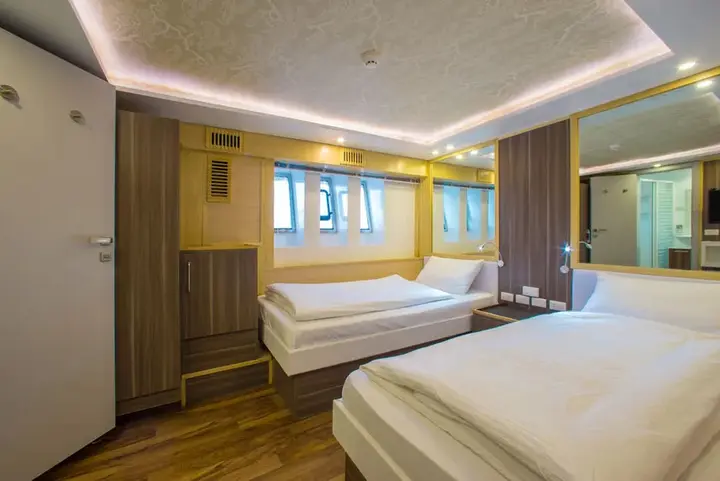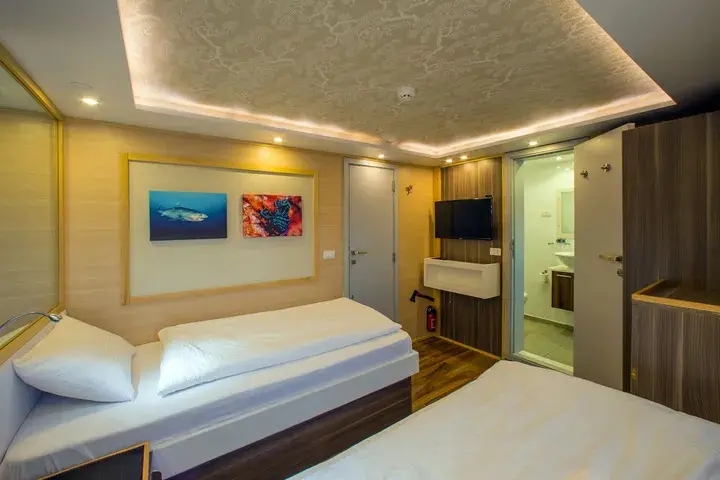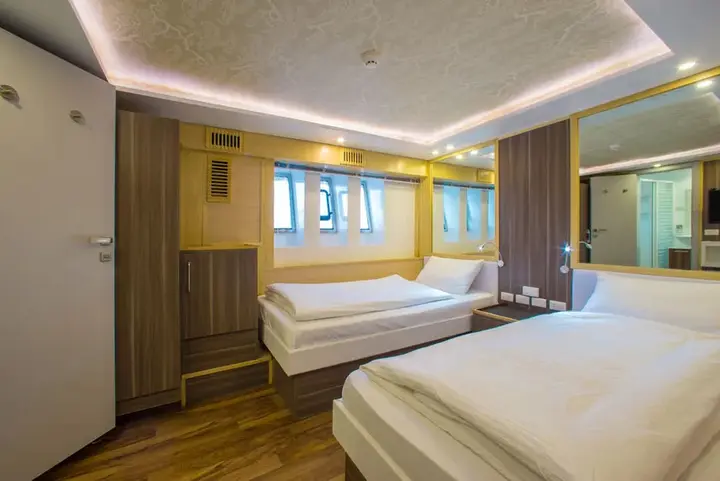The Red Sea is home to more than 1,200 species of fish, 20% of which are endemic, i.e. only found here.
The Red Sea attracts divers with its fascinating combination of biodiversity, spectacular dive sites, favourable conditions and well-developed infrastructure. Whether you are a beginner, experienced diver or technical diver, the Red Sea has something for everyone and leaves lasting impressions that keep divers coming back.
This website uses Google Maps to embed map material. Please note that your personal data may be collected in the process. To view the Google Maps map, please agree that it is loaded from the Google server.
The 43m MY Blue offers year-round diving safaris to the best of the Egyptian Red Sea. She has been equipped with modern amenities to provide comfort, luxury and space for 24 guests on board. There are 12 cabins to choose from, including 7 twin cabins on the lower deck, 4 sea view cabins with either twin beds or a double bed and 1 master cabin with a double bed. All cabins have a separate bathroom, shower, WC, hairdryer, TV/DVD combo, individually controlled air conditioning, safe and storage space. Social areas include the modern saloon with an entertainment system and a dining area where freshly prepared meals are served three times a day as well as various snacks between dives, soft drinks, water, tea and coffee.
MY Blue departs from Port Ghalib or Hurghada to reach some of the best destinations in the Red Sea, including the northern wrecks and reefs, Thistlegorm and Abu Nuhas, as well as the iconic southern marine parks of Rocky, Zabargad, Daedalus and Brothers. With up to 21 dives per week, this Red Sea liveaboard on the MY Blue is a must. There is a spacious dive deck at the stern of the boat and tenders for easy access to and from the dive sites. Nitrox is available free of charge for certified divers.
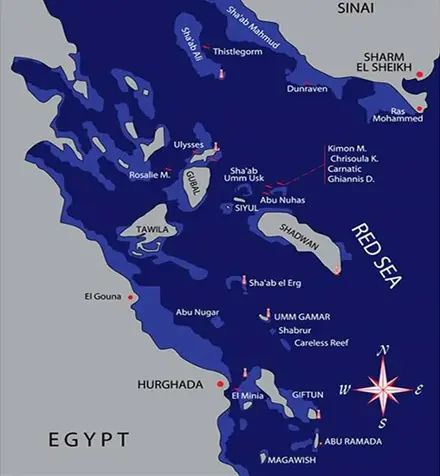
Brothers, Daedalus, Elphinstone (Port Ghalib - Hurghada) 8D/7N
Explore three of the most beautiful dive sites in the Red Sea. A great all-round tour for divers with a little more experience. There is so much to see that you will be spoilt for choice, but don't forget to look out in the blue. This safari offers challenging dives, big walls, beautiful coral walls and lots of big fish. Brother Islands, Daedalus & Elphinstone is a must for all die-hard Red Sea divers!
Big Brother: A 400 metre long island that offers fabulous wreck diving and wall diving. The wreck of the Numidia lies at the northern tip between 10 and 80 metres. On the north-west side of the island is the wreck of the Aida. At each section of this reef, the wall is covered with coral and life.
Small Brother: Has a very high concentration of life in a very small area. Fan coral forests, overhangs, hard and soft corals in a variety of amazing colours... and of course there are plenty of fish! With regular sightings of hammerhead sharks, thresher sharks, grey sharks and whitetip reef sharks, at the right time of year.
Daedalus: About 180 kilometres south of the Brother Islands, this huge reef is surrounded by a steep wall and strong currents that make for fantastic drift diving. The stony corals grow to huge sizes, but make sure you keep an eye on the blue!
Elphinstone Reef: A legend from the Red Sea. One of the most beautiful reefs, with its north and south plateau covered in hard and soft corals and harbouring pelagic reefs, this really is a fantastic reef.
Marine life: Wrecks, rays, oceanic whitetip sharks, octopus, lionfish, nudibranchs, frogfish, huge schools of fish, colourful reefs
All dive sites are weather dependent and the final itinerary is at the sole discretion of the captain and dive guides.
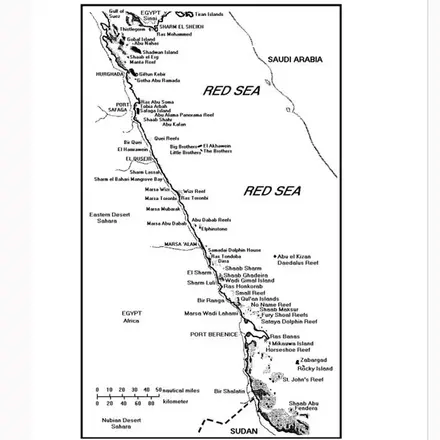
North & Tiran (Hurghada - Hurghada). 8D/7N
Similar to the North and Ras Mohamed itinerary, the Tiran Strait and North cruise allows you to see some of the Red Sea's most notorious wrecks and reefs as well as the pristine coral reefs of Tiran. The Tiran diving area is located at the entrance to the Gulf of Aqaba and consists of four main reefs that form the tip of an underwater bridge. These reefs, named after British cartographers (Jackson, Woodhouse, Thomas, Gordon), are world famous for their extraordinary variety of corals and strong south-westerly currents make them home to many large pelagic fish.
SS. Thistlegorm - Shaab Ali: Probably the most famous wreck in the Red Sea. The 129 m long English freighter was bombed by German aircraft on 6 October 1941. Today it creates an artificial reef on a sandy bottom at a maximum depth of 32 metres. It harbours an enormous variety of marine life and is particularly popular with large schooling fish.
Shaab Mahmoud: This is a small crevice in the centre of Shaab Mahmoud's barrier. Drift along the outer wall alongside beautiful corals and colourful fish. Look out for a sandy slope that will lead you up and through the crack. If the current is right, you can fly through the 5m deep channel and be thrown out over the sandy lagoon!
Shag Rock: This large circular reef is often overlooked, but offers excellent diving on pristine coral from anywhere on its edge.
Abu Nuhas: Also known as the "ship graveyard", this reef is dangerously close to the busy shipping lanes of the Gulf of Suez. This reef has claimed more ships than any other in the area. On the north side, four wrecks lie on a sandy seabed at the foot of a steeply sloping reef covered with table coral. On the south side is a safe anchorage for liveaboards and two ergs known as Yellow Fish Reef.
Marine life: Wrecks, rays, sharks, octopus, lionfish, nudibranchs, frogfish, huge schools of fish, colourful reef.
All dive sites are weather dependent and the final itinerary is at the sole discretion of the captain and dive guides.
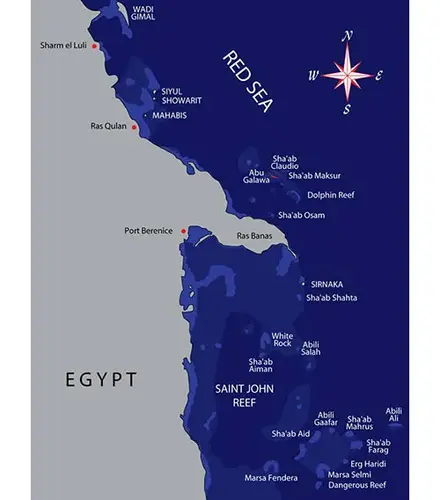
St John (Port Ghalib - Port Ghalib). 8D/7N
This tour is a little more challenging and offers large walls covered with huge gorgonians and colourful soft corals. On this safari, divers have the opportunity to explore a variety of truly unique dive sites, which include some very interesting and colourful corals.
Cave Reef is located one hour north of the main St John's area. Have fun navigating through tunnels and around pinnacles. A beautiful dive site on the Red Sea.
St John's Reef: This reef chain is located at the Tropic of Cancer and is the southernmost reef chain you will reach! All the dive sites are very close to each other, which means you can easily move from one site to another. It therefore brings a lot of variety to your dives: walls, tunnels and stunning hard coral formations. One of these dives (St John's Caves or Umm Kharalim) is truly unique and a photographer's paradise, with rays of light penetrating the beautiful tunnels.
St John's Reef North: Located one hour north of the main St John's area. Have fun navigating through tunnels and around peaks.
Fury Shoal : A huge chain of reefs that create a variety of excellent dive sites, including Abu Galawa to the north and Sataya to the south. Have fun exploring caves, tunnels, coral gardens, plateaus and drop-offs! Abu Galawa is located in Fury Shoal - have fun exploring the wreck of 'Tug Boat'. The reef also has good coral dives on the west side.
Marine life: Rays, sharks, octopus, lionfish, nudibranchs, frogfish, huge schools of fish, brightly coloured reefs, deep drop offs covered in vibrant corals in the bluest of blue seas. Sharks and other large pelagics are common as they come in and out of the reef. This is an amazing reef safari and a photographer's dream.
All dive sites are weather dependent and the final itinerary is at the sole discretion of the captain and dive guides. This trip starts and ends in Port Ghalib. This tour visits the reefs between Port Ghalib and St Johns.
Bow Cabin Twin Lower Deck
2 single beds,
en-suite bathroom,
controlled air conditioning,
2 guests
Twin Cabin Lower Deck
2 single beds,
en-suite bathroom,
controlled air conditioning,
2 guests
Sea View Cabins Double Bed Upper Deck
1 double bed,
en-suite bathroom,
controlled air conditioning,
2 guests
Sea View Cabins Twin Bed
2 single beds,
en-suite bathroom,
controlled air conditioning,
2 guests
Master Cabin Main Deck
1 double bed,
en-suite bathroom,
controlled air conditioning,
TV, 12sqm room,
2 guests
Included: VAT, airport transfers, hotel transfers, soft drinks, tea & coffee, drinking water, snacks, full board (all meals), nitrox, dive packages, snorkelling guide, towels for use on deck, cabin towels.
Mandatory extras: Park, Port and Fuel Fees (290 EUR per trip).
Optional extras: gratuities, visa and fees (30 EUR per trip), alcoholic drinks (3-20 EUR), rental equipment, Nitrox course (150-190 EUR), diving courses (90-155 EUR), snorkelling set.
Prices for rental equipment:
Rental equipment is available on this ship. Please indicate what you need on the booking form. Details below of what is included and the additional prices.
15 litre bottles 30 EUR
Regulators 35 EUR
BCD 35 EUR
fins 35 EUR
mask 35 Eur
Nitrox bottle included
snorkelling set 35 EUR
torch 35 EUR
Dive computer 35 EUR
Complete equipment (with: regulator, BCD, fins, mask, wetsuit) 135 EUR
Wetsuit 35 EUR
- Air temperature: Temperatures are warm all year round, with highs between 16.8 °C in January and 32.7 °C in August.
- Water temperature: Water temperatures vary between 21 °C in February and March and 28 °C in August, providing ideal conditions for diving activities.
- Rainfall: Rainfall is minimal in this region, with an average of less than 6 mm per month.
Egypt is located in north-east Africa and connects Africa with Asia via the Sinai Peninsula. The Red Sea stretches along the east coast of Egypt and is an important maritime region with rich marine life, clear waters and unique coral reefs.
Population & Religion
Egypt has over 100 million inhabitants, the vast majority of whom are Muslim (mostly Sunni). There are also small Christian minorities, mainly Copts. Religion plays a central role in social life.
Economic factors & tourism
Tourism is a mainstay of the Egyptian economy. In addition to cultural highlights such as the pyramids and temples, diving tourism on the Red Sea is an important economic factor, especially in regions such as Hurghada, Marsa Alam, Sharm El-Sheikh and Dahab. Diving and beach tourism creates numerous jobs in the hotel industry, catering, travel agencies and as diving guides.
Importance of diving in the Red Sea
The Red Sea is considered one of the most biodiverse seas in the world. It is known for:
- Coral reefs in excellent condition
- Year-round diving conditions due to warm water temperatures
- Diversity of marine life such as dolphins, sharks, turtles, moray eels and colourful reef fish
- Spectacular wrecks, e.g. the SS Thistlegorm
- Good underwatervisibility of up to 40 metres
These conditions make Egypt one of the world's favourite destinations for beginners and experienced divers alike.
Conclusion
Diving in the Red Sea is of great economic and ecological importance for Egypt. Not only does it contribute to regional development, but it also helps to raise awareness for the protection of marine ecosystems. Combined with cultural treasures, Egypt is a unique destination for recreation, adventure and nature experiences.

